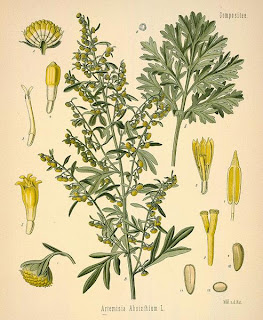Plant of the day Artemisia absinthium (Wormwood)
Wormwood has traditionally been used in the West to repel bugs from stored clothing, as a strewing herb, and the seeds taken internally in small amounts to get rid of worms (thus the name). Steeped in ink, wormwood would then protect the paper written on from being eaten by mice (because of its bitterness). It is antiseptic. But it is also a constituent of absinthe. This plant grows wild all over Europe and the US. The bitter component of wormwood is an alkaloid, absinthin, which is separate from the essential oil, thujone. Absinthin is removed by tincturing (soaking the plant in water or alcohol). Absinthe cannot be made by tincturing, only by distillation.
The root is perennial, and from it arise branched, firm, leafy stems, sometimes almost woody at the base. The flowering stem is 2 to 2 1/2 feet high and whitish, being closely covered with fine silky hairs. The leaves, which are also whitish on both sides from the same reason, are about 3 inches long by 1 1/2 broad, cut into deeply and repeatedly (about three times pinnatifid), the segments being narrow (linear) and blunt. The leaf-stalks are slightly winged at the margin. The small, nearly globular flowerheads are arranged in an erect, leafy panicle, the leaves on the flower-stalks being reduced to three, or even one linear segment, and the little flowers themselves being pendulous and of a greenish-yellow tint. They bloom from July to October. The ripe fruits are not crowned by a tuft of hairs, or pappus, as in the majority of the Compositae family.
The leaves and flowers are very bitter, with a characteristic odour, resembling that of thujone. The root has a warm and aromatic taste.
The Common Wormwood held a high reputation in medicine among the Ancients. Tusser (1577), in July's Husbandry, says:

No comments:
Post a Comment